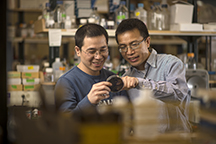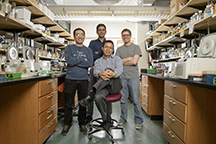April 18, 2016
A single enzyme with the power of three could offer shortcut to therapeutic target
 |
|
Zhao-Qing Luo, at right, a Purdue professor of biological sciences and member of the Purdue Institute for Inflammation, Immunology and Infectious Diseases, and postdoctoral researcher Jiazhang Qiu look at a petri dish with Legionella pneumophila bacteria. Luo and Qiu lead a research team that identified an enzyme that could independently accomplish ubiquitination, an important cellular signaling process being pursued as a therapeutic target. (Purdue University photo/Charles Jischke) |
WEST LAFAYETTE, Ind. — Researchers identified a single enzyme doing the work of a trio thought necessary to control a common cellular signaling process being pursued as a therapeutic target.
The signaling process, ubiquitination, plays an essential role in numerous important cellular processes such as immunity, which is frequently hijacked by pathogens to enable the spread of infection within a host, said Zhao-Qing Luo, a Purdue University professor of biological sciences and member of the Purdue Institute for Inflammation, Immunology and Infectious Diseases, who led the research.
“This signaling process is very important, and many companies are working to develop drugs to control it and use it to treat diseases,” Luo said. “This discovery is a paradigm shift because we had only known a cascade of three enzymes, named E1, E2 and E3, to initiate this process. If one enzyme could accomplish the same thing, it could potentially make the therapeutic goal easier to achieve. However, much more research needs to be done.”
Luo led a team studying Legionella pneumophila, the bacterium that causes Legionnaires' disease. A paper detailing the National Institutes of Health-funded research was published in the journal Nature and is available online.
Ubiquitination is one way a cell is told what to do through management of the proteins within it. The addition of a small protein named ubiquitin can mark another protein for destruction, relocation in the cell, or it can turn the protein on or off, which can trigger or stop a cellular process, Luo said.
Disease-causing pathogens have been shown to manipulate or attack the ubiquitination process to disarm immune cells and evade the body’s defense mechanisms, he said.
In all ubiquitination previously observed, the cascade of three E enzymes performed a sort of relay in which one activated a ubiquitin protein, one transferred it to the target protein and one attached it, he said
 |
|
Zhao-Qing Luo, seated, with, standing from left, Jiazhang Qiu, Chittaranjan Das, and Michael Sheedlo. Luo, a Purdue University professor of biological sciences and member of the Purdue Institute for Inflammation, Immunology and Infectious Diseases, led a team of researchers that identified an enzyme that could accomplish ubiquitination, an important cellular signaling process being pursued as a therapeutic target. (Purdue University photo/Charles Jischke) |
Luo’s team investigated Legionella pneumophila’s use of the process to inactivate proteins within a cell’s endoplasmic reticulum to benefit bacterial replication, and identified a family of proteins the bacteria used to accomplish the task. The researchers discovered that each protein within the family was able to independently accomplish ubiquitination.
“This finding was totally unexpected,” said Purdue postdoctoral researcher Jiazhang Qiu, who is a member of the research team. “Not only does one molecule independently accomplish ubiquitination, it does this in an entirely different way. It really changes everything we thought we knew about this important process.”
The team found another unique aspect of the ubiquitination process is the use of a molecule named nicotinamide adenine dinucleotide, or NAD, as a source of energy. The common cellular energy source Adenosine Triphosphate, or ATP, had been used in all other observed ubiquitination and was thought necessary for the process, he said.
In addition to Luo and Qiu, members of the research team include graduate student Michael J. Sheedlo; associate professor of chemistry Chittaranjan Das; collaborators Kaiwen Yu and Xiaoyun Liu of Peking University in Beijing; Ernesto S. Nakayasu of Pacific Northwest National Laboratory; and Yunhao Tan a former graduate student in Luo’s group who is now at Boston Children’s Hospital.
The study of bacteria, which have evolved with humans, can uncover important processes and information that apply to human health, Luo said.
“If this same alternative ubiquitination process occurs in humans, perhaps an engineered ubiquitin-editing protein could be developed to target and control processes critical to the development of many diseases, including infection,” Luo said. “If that is the case, this could lead to a very precise way to target and treat disease.”
The team’s discovery marks an early success of the new Purdue Institute for Inflammation, Immunology and Infectious Diseases in Purdue’s Discovery Park.
The institute is part of the university’s new Pillars of Excellence in the Life Sciences Initiative. The Purdue Institute for Inflammation, Immunology and Infectious Diseases (PI4D) along with the Center for Integrative Neuroscience were two “pillars” selected to amplify Purdue’s existing strengths and complement the Purdue Moves initiatives in order to enable research at the highest level and with the greatest impact on human lives.
The initiative was implemented as a partnership of pillar leadership teams and the offices of Purdue’s Executive Vice President for Research and Partnerships and Provost. It also is coupled with Purdue’s recently announced $250 million investment in the life sciences.
Purdue Moves is an initiative designed to broaden the university's global impact and enhance educational opportunities for its students. All of the moves fall into four broad categories: science, technology, engineering and math (STEM) leadership; world-changing research; transformative education; and affordability and accessibility.
Writer: Elizabeth K. Gardner, 765-494-2081, ekgardner@purdue.edu
Sources: Zhao-Qing Luo, 765-496-6697, luoz@purdue.edu
Jiazhang Qiu, 765-494-4929, qiujiazhang1983@163.com
Related news releases:
Purdue scientists reveal how bacteria build homes inside healthy cells
Researchers identify a new trigger of cellular self-destruction
Purdue biologists identify new strategy used by bacteria during infection
ABSTRACT
Ubiquitination independent of E1 and E2 enzymes by bacterial effectors
Jiazhang Qiu, Michael J. Sheedlor, Kaiwen Yu, Yunhao Tan, Ernesto S. Nakayasu, Chittaranjan Das, Xiaoyun Liu & Zhao-Qing Luo
Signaling by ubiquitination regulates virtually every cellular process in eukaryotes. Covalent attachment of ubiquitin to a substrate is catalysed by the E1, E2 and E3 three-enzyme cascade1, which links the carboxy terminus of ubiquitin to the ε-amino group of, in most cases, a lysine of the substrate via an isopeptide bond. Given the essential roles of ubiquitination in the regulation of the immune system, it is not surprising that the ubiquitination network is a common target for diverse infectious agents2. For example, many bacterial pathogens exploit ubiquitin signaling using virulence factors that function as E3 ligases, deubiquitinases3 or as enzymes that directly attack ubiquitin4. The bacterial pathogen Legionella pneumophila utilizes approximately 300 effectors that modulate diverse host processes to create a permissive niche for its replication in phagocytes5. Here we demonstrate that members of the SidE effector family of L. pneumophila ubiquitinate multiple Rab small GTPases associated with the endoplasmic reticulum. Moreover, we show that these proteins are capable of catalysing ubiquitination without the need for the E1 and E2 enzymes. A putative mono-ADP-ribosyltransferase motif critical for the ubiquitination activity is also essential for the role of the SidE family in intracellular bacterial replication in a protozoan host. The E1/E2- independent ubiquitination catalysed by these enzymes is energized by nicotinamide adenine dinucleotide, which activates ubiquitin by the formation of ADP-ribosylated ubiquitin. These results establish that ubiquitination can be catalysed by a single enzyme, the activity of which does not require ATP.
Nature DOI: 10.1038/nature17657 http://www.nature.com/nature/journal/vaop/ncurrent/full/nature17657.html
This research was supported by National Institutes of Health grants R56AI103168, K02AI085403 and R21AI105714 (Z.-Q.L.), 2R01GM103401 (C.D.) and National Natural Science Foundation of China grants 21305006 and 21475005 (X.L.).

